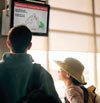Mass Notification Moves to More Enterprises

The REACT
critical response notification system can use virtually any means to receive
and deliver information – telephones, pagers, desktop PC screens, e-mail,
mobile text messaging, public digital displays and all types of handheld
devices.
Begun in colleges, mass notification systems are now moving into a diversity of enterprises. The Seton Family of Hospitals in Austin, Texas is a beacon of progress in healthcare, meeting urgent challenges.
Seton’s prominence and vulnerability to disruption necessitated a critical response notification system of the highest integrity, reliability and functionality. After evaluating many options, Seton decided to look into a mass notification system. The solution is built from the ground up to unify critical action and coordinate effective response. Led by a team of veteran technologists and emergency communications experts, the organization picked REACT Systems to help Seton prepare for, respond to, and manage emergencies.

A System to Serve Millions
Seton has a total of 43 buildings located not only in Austin but also throughout the surrounding areas. Adding to the challenge, each facility has its own administration, organization plan and IT system. Only a solution that was highly scalable, standards-based and fully engineered could centralize, coordinate and disseminate information smoothly within and among those facilities – and with outside agencies such as fire departments and police. The system’s flexibility and ease of configuration met the unique needs of each building and fit into the overall security plan. And the system can uses virtually any means to receive and deliver information – telephones, pagers, desktop PC screens, e-mail, mobile text messaging, public digital displays and all types of handheld devices.Multiple, concurrent alerts can also convey diagrams, photos, video and/or voice instructions. These instantaneous, accurate notifications help manage and confine all manner of emergencies such as disturbed or threatening persons, natural disasters, criminal activity, medical code alerts, fire and hazmat alerts, evacuation and mustering instructions.

Screens located
throughout the hospital show visitors and employees alike alerts and general
information.
Communications for a New Pediatric Resource
Seton recently opened the Dell Children’s Medical Center of Central Texas, offering a spectrum of advanced services at the forefront of pediatric medicine. The Dell Children’s Center exemplifies how technology improves patients’ and visitors’ experiences. The notification system lets Seton respond quickly to keep children safe, plus educate visitors about services offered by the hospital.In addition, powered screens in emergency rooms communicate policies, such as informing people that they may not be seen in order of arrival but rather according to the seriousness of their condition, or reminding patients not to consume food because that can interfere with patient treatment. So far, Seton’s communication managers have seen a dramatic reduction in the volume of calls needing to be handled by personnel as a result of public communications capabilities.
Giving Staff, Patients and Visitors Vital Information
In a hospital setting, even so-called “routine” procedures are key to safeguarding lives. The REACT system provides an added safety margin by enabling visual reminders to observe safety protocols. For staff, the system delivers instructions about best practices, physician scheduling, records keeping and many other processes, which reinforces consistency, accountability and training. Public displays help visitors and patients obtain directions and get health tips on nutrition and immunization.A primary reason for Seton’s commitment to the system is so the organization would have reliable communications when usual methods failed. Recently, an ice storm struck the Austin area and closed roads – but, even managers not able to reach the office were able to manage the situation, communicating effectively with staff and scheduling changes as a result of the storm.
Looking for a reprint of this article?
From high-res PDFs to custom plaques, order your copy today!







